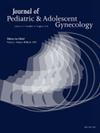60. Kleinfelter Mosaicism in a Phenotypic Female: A Case Report
IF 1.7
4区 医学
Q3 OBSTETRICS & GYNECOLOGY
引用次数: 0
Abstract
Background
Kleinfelter Mosaicism is a rare phenomenon, with only about 20 cases of 47, XXY/ 46, XX mosaicism reported in the literature. Of these, only two patients were phenotypically female, lending little data to predict the risk of germ cell tumors or the status of future fertility for our phenotypically female patient. This poster aims to review the recorded cases of 47, XXY/ 46, XX mosaicism to increase awareness of this rare condition and to discuss the relationship of this condition to other differences in sexual development in order to assess the specific health risks our patient may face.
Case
Our patient presented as a 10 month old female who had an abnormal NIPT indicating an abnormality of the Y chromosome. A karyotype analysis at age 4 weeks revealed 47, XXY [5] / 46, XX [45] and subsequent FISH analysis for the SRY gene revealed the presence of the Y chromosome in 11.5% of nuclei. The patient had normal appearing external female genitalia on physical exam and had no other concerns with health or development. Labs at age 6 months revealed normal hormone levels and U/S identified a small uterus and a candidate for a right ovary, but did not visualize a left ovary. Parents opted for no intervention at this time and they were advised to request that her pediatrician provide biannual abdominal exams to assess for masses and to return to the Differences in Sexual Development clinic every 3-4 years for further evaluation.
Comments
Kleinfelter Syndrome as a whole is associated with higher rates of germ cell tumors than the general population. The other reported cases of 47, XXY / 46, XX type of Kleinfelter mosaicism share similarities with both ovotesticular DSD (OT-DSD) and complete gonadal dysgenesis (OT-DSD). Both of these conditions have different risks associated with germ cell tumors and different fertility profiles. All but two of these cases, however, developed as phenotypic males, leaving a gap in the medical community's understanding of how our patient might develop.
60. Kleinfelter嵌合现象在表型女性中的一例报道
kleinfelter Mosaicism是一种罕见的现象,文献中仅报道了约20例47,XXY/ 46, XX镶嵌画。在这些患者中,只有两名患者是表型上的女性,这为预测生殖细胞肿瘤的风险或我们表型上的女性患者未来的生育状况提供了很少的数据。这张海报旨在回顾47,xxy / 46,xx马赛克的记录病例,以提高对这种罕见疾病的认识,并讨论这种疾病与性发育其他差异的关系,以评估我们的患者可能面临的具体健康风险。病例:我们的患者是一个10个月大的女性,NIPT异常表明Y染色体异常。4周时的核型分析显示47、XXY[5] / 46、XX[45],随后的SRY基因FISH分析显示11.5%的细胞核中存在Y染色体。体格检查显示女性外生殖器外观正常,无其他健康或发育问题。6个月大的实验室检查显示激素水平正常,U/S检查发现子宫小,右侧卵巢候选,但未见左侧卵巢。此时,家长选择不进行干预,并建议他们要求儿科医生提供两年一次的腹部检查,以评估肿块,并每3-4年返回性发育差异诊所进行进一步评估。评论:与一般人群相比,整个患者的生殖细胞肿瘤发病率更高。其他报告的47、XXY / 46、XX型Kleinfelter嵌合与卵睾丸DSD (OT-DSD)和完全性腺发育不良(OT-DSD)有相似之处。这两种情况都有不同的风险与生殖细胞肿瘤和不同的生育特征相关。然而,除了两例之外,所有这些病例都发展为表现型男性,这在医学界对我们的病人如何发展的理解上留下了空白。
本文章由计算机程序翻译,如有差异,请以英文原文为准。
求助全文
约1分钟内获得全文
求助全文
来源期刊
CiteScore
3.90
自引率
11.10%
发文量
251
审稿时长
57 days
期刊介绍:
Journal of Pediatric and Adolescent Gynecology includes all aspects of clinical and basic science research in pediatric and adolescent gynecology. The Journal draws on expertise from a variety of disciplines including pediatrics, obstetrics and gynecology, reproduction and gynecology, reproductive and pediatric endocrinology, genetics, and molecular biology.
The Journal of Pediatric and Adolescent Gynecology features original studies, review articles, book and literature reviews, letters to the editor, and communications in brief. It is an essential resource for the libraries of OB/GYN specialists, as well as pediatricians and primary care physicians.

 求助内容:
求助内容: 应助结果提醒方式:
应助结果提醒方式:


